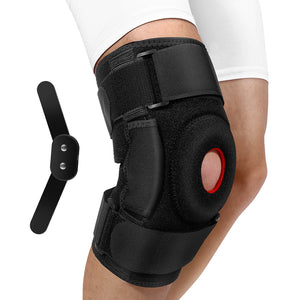How Long Can Tendonitis Last?

Do you know what moves your limb or pulls the bone when you exercise? That’s the role of a flexible tissue called the tendon that facilitates movement.
Different joints contain tendons, and each one performs the crucial function of connecting your muscles to bones. However, overuse or repetitive motions can damage your tendons, leading to musculoskeletal disorders such as tendonitis.
This inflammation of the tendons restricts you from performing everyday activities. How long can tendonitis last? To get the answer, let’s discuss the causes, symptoms, types, and prevention methods of tendonitis one by one below.

Types of Tendinitis
Before knowing “how long can tendonitis last,” you should learn about the different types of this joint disorder.Generally, tendonitis affects various body parts and can occur anywhere in the body, including the knee, elbow, or shoulder. Based on the affected body region, here are some common types of tendonitis:
1. Tennis Elbow
One of the most common types of tendonitis is tennis elbow or lateral epicondylitis. It results from inflammation of the muscles of the forearm and below the elbow region.This condition is often found in tennis players, as they are involved in the repetitive movement of the forearm. The repetitive lifting, bending, or twisting of the forearm during any activity can cause this health disorder.
2. Runner’s Knee
An inflammation around the kneecap or in front of the knee can lead to a runner’s knee, also known as patellar tendonitis. It affects the patellar tendon that connects the patella and tibia. This type of tendonitis is caused by overuse of the knees or performing high-intensity exercises. Once developed, the runner’s knee can last 4–8 weeks. [1]
3. Swimmer’s Shoulder
Another common type of tendonitis affects the rotator cuff tendon of the shoulder joint. Swimmer’s shoulders are mainly caused by frequent overhead movements of the shoulder joint during swimming, which can result in repeated pressure and impact on the shoulder muscles and tendons, leading to inflammation of the tendons and joints.Its symptoms may include shoulder pain during rest or at night, decreased mobility, and weakened shoulder strength.
4. Achilles Tendinitis
When you put stress on the Achilles tendon, it causes degeneration of the tendon that connects the heel to the calf muscles.Achilles tendonitis results from excessive workouts, such as running, and can cause stiffness in the lower leg. If you’re wondering how long does it take for tendons to heal, the recovery time can take about 2–3 weeks.
5. De Quervain's Tenosynovitis
De Quervain's tenosynovitis is an inflammation that affects the tendon of the thumb. This causes painful movement, and you might find it difficult to move your wrist and make a fist. This type of tendinitis often occurs due to excessive use of the thumb, such as continuously holding a baby. Although temporary, this tendonitis type can last for 4 to 6 weeks.Symptoms and Causes of Tendinitis
Tendonitis is often associated with the overuse of tendons or repetitive tasks such as playing sports. It can lead to chronic pain, and you might need to perform surgery for treatment. Therefore, knowing the early signs and causes of tendonitis is always advised. Symptoms include:
- Pain in the affected body part, especially during movement
- A lump or swelling around the tendon
-
Reduced range of mobility
Besides, you might also feel muscle weakness or tenderness in the affected area. Learning what causes this muscle disorder is important. Enlisted below are some of its leading causes:
- Overuse of tendons from repetitive motions
- Side effects of medication
- Health disorders such as diabetes or osteoarthritis
- Injury or infection around the joints
- Osteoarthritis

How Long Can Tendonitis Last?
Now that you know the symptoms and causes, it’s time to get a precise answer to “How long can tendonitis last”? Generally, the tendon healing time can vary depending on the type of tendonitis and the treatment method used. Let’s discuss both in detail below:
1. Shoulders
Shoulder tendonitis can restrict the movement of your rotator cuff and biceps. Once developed, the tendon injury healing time can take about 6 weeks or months. The specific recovery time will depend on the severity of the injury and the pain. You can take medicine or use a shoulder brace for tendonitis on the affected area for relief.
2. Elbow
The majority of the tendonitis cases include inflammation of the elbow or forearm muscles. This can prevent you from bending or rotating your elbow. Thus, you cannot perform everyday tasks such as writing. Its duration can vary from 6 to 12 months, but it can be treated within several weeks if you take the necessary precautions. To know how to prevent tendonitis, you should consult your healthcare professional or use home treatment methods.
3. Knees
The answer to “How long can tendonitis last?” lies in your treatment methods. For instance, if treated properly, knee tendonitis can go away in 4–8 weeks or less.This involves adequate rest, therapy, or mild strengthening exercises. If you still experience chronic pain, you can use the knee brace for patellar tendonitis, as it will provide the maximum support and comfort.
4. Feet
Tendonitis around your feet or ankles often causes excessive pain and swelling, leading to discomfort over time. This can cause Achilles tendonitis, which takes 2 to 3 weeks for a mild injury.If the pain increases, it can take six weeks to a few months for a complete recovery. Common preventive measures include using an ankle brace for Achilles tendonitis and heat or cold therapy.
5. Thumb
De Quervain's tenosynovitis, or inflammation around the thumb, can cause soreness and severe pain. A massage or physical therapy session can treat it within 4 to 6 weeks.You should move your wrist carefully and use specialized devices such as a blue wrist brace that reduces inflammation for complete healing.
How to Prevent Tendonitis?
The measures to prevent tendinitis are very important, as they can help reduce the risk of injury and maintain the health of muscles and tendons. Here are some effective prevention strategies:
1. Take Appropriate Rest
Ensuring sufficient rest time for the body during exercise and daily activities can prevent excessive use of tendons and fatigue. This fundamentally reduces the risk of tendon injury.
2. Warm-up and Correct Posture
Preparing sufficient warm-ups and correct postures before starting any exercise can reduce the additional pressure caused by poor posture.
3. Suitable Protective Braces
Besides general preventive measures, a practical way is to use braces for protection against tendonitis. These braces are designed to offer support and comfort during chronic or acute tendon injuries. They also provide stability and reduce the risk of injury.Fivali provides multiple braces for different body parts, including shoulder, knee, elbow, and wrist braces. Our protective braces are made with comfortable materials for specific body areas.
For instance, you can get maximum flexibility and breathability for extended periods with a wrist brace for tendonitis. It can provide additional support and protection for easily injured tendons and shoulder joints.
4. Avoid High Training Intensity
High-intensity workouts can cause tissue damage and increase the risk of pain or swelling. It’s better to gradually increase the intensity of exercise according to your condition to reduce the impact and pressure on the tendons.Moreover, if you feel pain or discomfort during an activity, you should immediately stop and evaluate the situation. Early identification and intervention can prevent damage from worsening.

The treatment methods include using medications, ice or heat therapy, or wearing Fivali protective braces. These braces are optimal for bringing you back to the normal recovery phase so you can perform your everyday tasks comfortably. Browse Fivali’s website to select the one for you!
References
[1] Patellofemoral Pain Syndrome (PFPS). Available at: https://my.clevelandclinic.org/health/diseases/17914-patellofemoral-pain-syndrome-pfps (Accessed: 24 June 2024)













